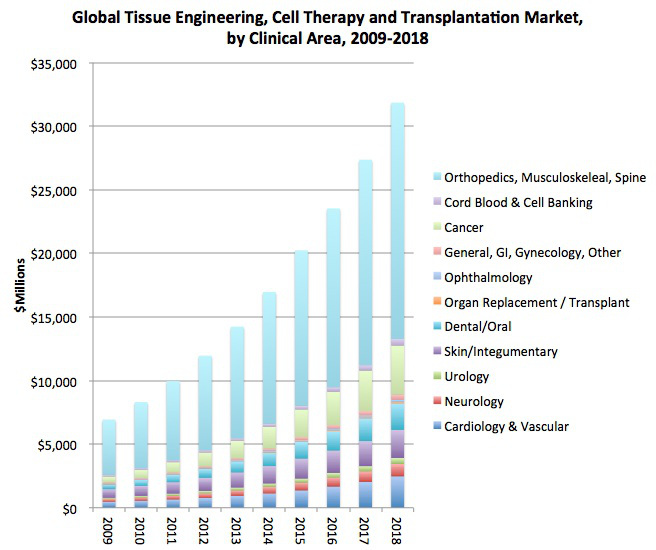Stem Cell Market
Global Stem Cell Market
Many scientists in bio and medical fields have a lot of experience and knowledge in stem cell research, cell cryopreservation and therapies.
Using the stem cell, various clinical researches are undergoing for diseases.
In other words, the key of stem cell therapy is the regenerative medicine.
Cell therapy and medicine using stem cell have been increasing explosively since 2000.
Various studies for prevention and therapy of disease and anti-aging have been increasing steadily.
- Research Institutes
- Research Hospitals
- Clinical research Institutes
- Bio Companies
- Related Journals
- Cell Banking Companies
- Cell Therapy Medical Institution
Many institutes go on intensive R&D and forming new market. And common targets worldwide are commercialization of stem cell therapy.
Stem cell, next generation of bio field is national competitiveness and will be red-hot market.
Tissue Engineering, Cell Therapy and Transplantation: Products, Technologies & Market Opportunities, Worldwide, 2009-2018.

Global Cell and Tissue Market in 2010 and 2018

Source : http://www.mediligence.com/rpt/rpt-s520.htm MedMarket Diligence, LLC
See Detail
Tissue engineering and cell therapy comprise a market for regenerative products that is expected to grow worldwide to almost $32 billion by 2018. This market spans many specialties, the biggest of which is therapies for degenerative and traumatic orthopedic and spine applications. Other disorders that will benefit from cell therapies include cardiac and vascular disease, a wide range of neurological disorders, diabetes, inflammatory diseases, and dental decay and/or injury. Key factors expected to influence the market for regenerative medicine are continued political actions, government funding, clinical trials results, industry investments, and an increasing awareness among both physicians and the general public of the accessibility of cell therapies for medical applications.
On a country-by-country basis, there is considerable variation in the forces impacting the clinical practice and industry of cell therapy especially, but also tissue engineering, and these forces are fluid over time. Certainly among the most significant was President Bush’s Presidential Executive Order in 2001 banning federal funds for embryonic cell therapy other than for existing cell lines, an order that President Obama promptly rescinded after the 2008 election. The 2001-2008 hiatus impeded development of embryonic cell therapy solutions, while shifting the emphasis of development toward adult stem cell technology. Now, in 2012, development is moving rapidly on both fronts.
The overall challenges in development of future cell/tissue therapy products, regardless of clinical area, can be grouped into those associated with material-based tissue replacements, allograft-derived tissue replacements and cell and tissue-engineered products.
Material-based replacements. The search for synthetic-based biocompatible materials has posed particular problems for researchers in that no synthetic material is completely accepted and integrated by the body. Therefore, the goal has been to create a replacement tissue that closely mimics natural tissue and will activate normal body healing and tissue reconstruction, and eventually be resorbed harmlessly into the body after normal healing has begun.
Allograft-derived tissue replacements. Allograft (donated cadaver) tissues, are in short supply and must be thoroughly processed to remove any viruses, bacteria and other possible sources of transmission of disease. In addition to stringent cleanliness standards, companies must adhere to strict national laws regulating the donation of organs, and the harvesting and processing of such organs. Each country determines its own ethical standards for organ donation.
Cell and tissue engineered products. The biggest hurdle remaining to the creation of viable, commercialized embryonic or adult stem cells is to develop the ability to differentiate cells into various types of cells and to determine how these differentiated cells behave when cultivated in large numbers in the laboratory. In many cases, researchers are still uncertain whether the cells retain their characteristics over time or if they will degenerate into a different or earlier version of a cell.
Given the number of clinical applications — across multiple clinical specialties — that emerge from advances in basic cell therapy and tissue engineering research, the opportunities are obvious and are therefore the focus of intense commercial development by drug companies, biotech companies, device companies and every other type of company. The distribution of actual cell/tissue revenues across such a diverse array of companies has ensured that the as yet unrealized potential will be the focus of a highly competitive list of companies.


Leave a reply
You must be logged in to post a comment.